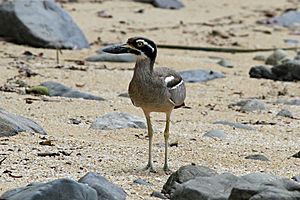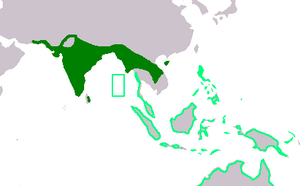Beach stone-curlew facts for kids
Quick facts for kids Beach stone-curlew |
|
|---|---|
 |
|
| Conservation status | |
| Scientific classification | |
| Genus: |
Esacus
|
| Species: |
magnirostris
|
 |
|
| E. magnirostris range E. recurvirostris range | |
| Synonyms | |
|
Esacus neglectus |
|
The beach stone-curlew (Esacus magnirostris), also known as the beach thick-knee, is a large bird that lives on the ground. You can find it in places like Australasia and the islands of Southeast Asia. This bird is quite big, weighing about 1 kilogram (2.2 pounds) and standing around 55 centimeters (22 inches) tall. It is one of the heaviest shorebirds in the world, not counting gulls and skuas.
Contents
About the Beach Stone-Curlew
What Does It Look Like?
The beach stone-curlew is a large bird with long legs and a thick bill. Its feathers are usually sandy brown, which helps it blend in with its beach surroundings. It has big, yellow eyes that help it see well, especially when it's looking for food.
How Does It Behave?
Unlike many other stone-curlews, this bird is not always active only at night. You might see it looking for food during the day too. It moves slowly and carefully, taking short runs now and then. If it sees you, it tends to be shy and will fly away. Its wingbeats are slow and look a bit stiff.
Where Does It Live?
The beach stone-curlew prefers quiet, open beaches, exposed reefs, and areas with mangroves. It also likes tidal sand or mudflats. These birds live across a wide area. You can find them along the coast of eastern Australia, including southern Victoria. They also live along the northern Australian coast and nearby islands. Other places they call home include New Guinea, New Caledonia, Indonesia, Malaysia, and the Philippines.
This bird is not very common in most of these places. It is quite rare south of Cairns.
How Do They Lay Eggs?
Female beach stone-curlews lay only one egg. They place it right above the high tide line on an open beach. This spot makes the egg easy for predators to find. It is also vulnerable to people disturbing it.
Protecting the Beach Stone-Curlew
The beach stone-curlew is listed as "Near Threatened" on the IUCN Red List. This means that while it's not in immediate danger, its population could become threatened if we don't protect its habitats. Protecting their nesting sites from predators and human activity is very important for their survival.
Images for kids
See also
 In Spanish: Alcaraván picogrueso australiano para niños
In Spanish: Alcaraván picogrueso australiano para niños





